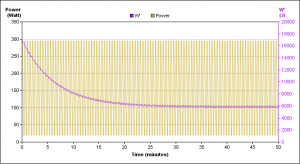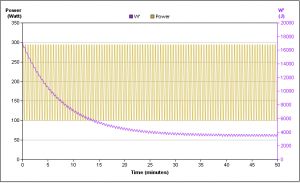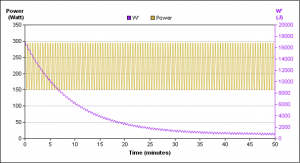The post-season can quickly become silly-season in the sporting world. Irrespective of the sport, athletes are looking for new and different ways to train; a magic formula that will give them a leg up in the spring. For this reason, the “microinterval” seems to come up every year. Physiologically, it’s an interesting exercise mode. As I discuss in my book, Scientific Training for Triathletes, the method was first widely popularized by Dr. Veronique Billat. Essentially, the on and off intervals are typically kept between 15 and 30 seconds. The work intervals are typically considerably above the critical power (CP, for cycling) or critical velocity (CV, for running). The recovery intervals are typically quite easy. Athletes love these workouts, because they can do a lot of intervals, and the ‘on’ intervals look impressive. However, microintervals may not represent the best training stimulus for what you are looking to eventually achieve. Let’s use the W’ balance model, which is being implemented in Golden Cheetah as we speak, to do some simulations.

Figure 1: 'Microinterval' workout. Note that the W' remaining never approaches 0, suggesting the athlete will not become exhausted...at least not right away.
The athlete has a CP of about 230W and a W’ of about 17 kJ. (Think of the W’ as a battery you deplete when you surge, and which recharges a bit when you recover.) They decide to do about 290W “on” and 20W “off” for 15 seconds at a time. You’ll note that the athlete doesn’t ever get very close to fatigue. This is why athlete’s tend to like these sort of workouts. They don’t feel very hard 🙂 . When I execute a similar workout, I feel like I can go on forever.
Now, you are probably looking at this graphic and saying, “Sure Dr. Phil, but I don’t freewheel on my recovery intervals.” Fair enough. Let’s run another simulation, and make the athlete instead do a more active recovery of around 100W. Will this make a significant difference in terms of the amount of fatigue they experience?
Recall that how quick you recover has to do with the difference between CP and recovery power. The lower you drop below CP, the faster you recover. As you can see in Figure 2, although the W’ balance remaining falls a bit more, the athlete is still a fair way from predicted exhaustion, even if they do this for close to an hour. I can do this without too much of a problem, but it certainly isn’t as easy as a 20W recovery.

Figure 2: Microinterval workout using the same work interval, but bringing the recovery power up to 100W
So, now you might be feeling pretty proud of yourself after pulling off the first 2, and decide you are going to try to recover at an even harder power output. So, we choose some gearing or trainer resistance that makes the recovery interval to 150W. What happens then?
As you might imagine, our simulation tells us that this is going to be harder still. You’ll spend the second half of the ride wondering if you should just quit. To do something like this, you’ll probably want to have an extra coffee. It also helps if you have some grad students in the lab with you to cheer for you or hurl abuse. Think Burgess Meredith in ‘Rocky’.
When you get that close to a W’ balance of zero, it becomes doubly important that you have a very good model set up. Any estimate of the CP or W’ has an error associated with it, which is easily calculable. Going by the literature, you can nail down the CP to within a couple of watts, but it isn’t easy to pinpoint the W’ to closer than about a kJ or so. Be really rigorous with yourself when you establish your CP and W’. If you can offer those aforementioned grad students some beer and pizza to hang around and motivate you when you are doing your predictive trials, it will help. If you don’t have numbers you can trust, the model will tell you that you can do something which you can’t.
What does all this mean, in the final analysis? In the paper where we developed this model, you’ll note we correlated the depletion of W’ with the rise in VO2 during interval exercise. One way of gauging exercise is by the oxygen use required to execute it. The logical inference is that ‘microinterval’ exercise might not yield the same stress / strain to your physiology as more ‘traditional’ interval training.
You’ll also want to remember that oxygen uptake isn’t everything. At the Baltimore ACSM meeting a few years ago, Dr. Billat reported that with particular manipulation of work and rest duration, she can keep people at or near VO2max for a really long time. That doesn’t necessarily mean it constitutes a great way to train. The principle of specificity still applies.
It’s also important to remember that just because you don’t bottom out the W’, you can’t expect to exercise forever. As I mention in another article, one line of thought is that the CP represents a line below which glycogen (i.e. how much carbohydrate your body has in storage) is a limiter. With all this work, you are going to be burning through a considerable amount of glyogen. Remember: your body has lots of reasons it may want to quit: W’ depletion, glycogen depletion, dehydration, a rise in core temperature, etc. Different workouts or environmental conditions will stress different systems, which may result in a different proximate cause of stopping for donuts in each case.
This begs the question, “Where should I use microintervals?” Good question. We’ll cover that in a future article.
—
Dr. Skiba’s forthcoming book, Performance Engineering: A Drug-Free Approach To Elite Sport, is coming soon to a store near you


